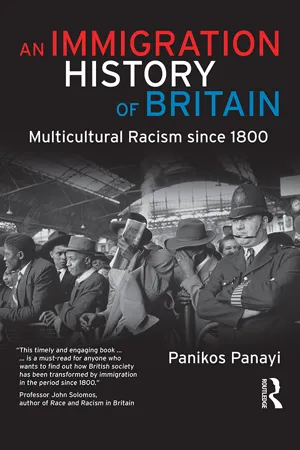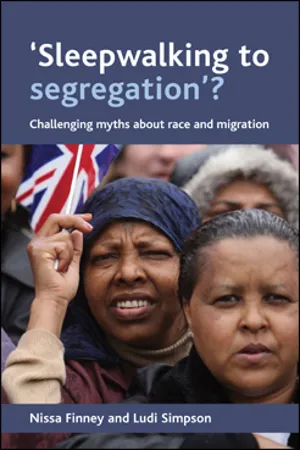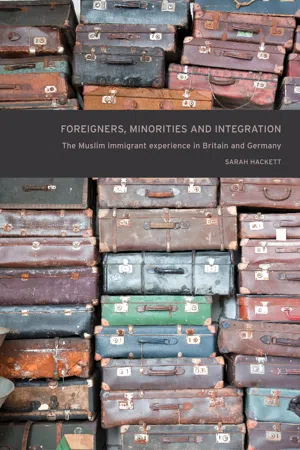History
UK Immigration
UK immigration refers to the movement of people into the United Kingdom from other countries. Throughout history, the UK has experienced waves of immigration, including significant influxes from former colonies and other parts of the British Empire. Immigration policies and attitudes have evolved over time, shaping the cultural and demographic landscape of the UK.
Written by Perlego with AI-assistance
Related key terms
6 Key excerpts on "UK Immigration"
- eBook - ePub
An Immigration History of Britain
Multicultural Racism since 1800
- Panikos Panayi(Author)
- 2014(Publication Date)
- Routledge(Publisher)
But there is no doubt that the histories and memories of immigration in Britain are strong, and are probably growing stronger. Technological developments have helped migrants preserve their own ethnic memories through closer connections with their homelands, and have simultaneously given impetus to community history projects which work with these memories. Immigration history may in some respects still remain marginalized, but it is undeniably dynamic and will continue to grow.Despite the fact that the mainstream historical profession may still tend to ignore the importance of immigration in the evolution of the British nation state, migrants themselves have increasingly attempted to bring their experiences to the attention of wider British society, albeit with limited success. It is more comfortable for those of migrant origins themselves to accept Britain as a country of immigration than it is for those who are not, whether this assertion refers to the historical profession or wider society.Immigration before 1800Another way of addressing the issue of Britain as a country of immigration lies in examining population movement towards the country throughout its history. Referring to the USA Oscar Handlin, in his now classic study on the subject, began his book by asserting: ‘Once I thought to write a history of immigration in the USA. Then I discovered that the immigrants were American history’.76 It may prove more difficult to apply such a bold phrase to the development of Britain over the last two centuries, but an analysis of the whole course of British history would indicate the way in which migration to the British Isles helped to create the peoples who would eventually describe themselves as British or English by the eighteenth and nineteenth centuries. Robert Winder has recognized this fact in his Bloody Foreigners: The Story of Immigration to Britain, which precisely takes this long-term approach. William Cunningham took a similar view, although his volume began with the Norman Invasion.77 Colin Holmes, meanwhile, briefly examined invasions until 106678 and also tackled streams of people who moved into the country between the middle of the eleventh and the middle of the nineteenth centuries.79 - eBook - ePub
'Sleepwalking to segregation'?
Challenging myths about race and migration
- Finney, Nissa, Simpson, Ludi(Authors)
- 2009(Publication Date)
- Policy Press(Publisher)
It is clear that historically, and in political, media and public discourses over the last decade, immigration has been established as a problem. The claim that there is too much immigration and that an acceptable level can and must be enforced frames thinking about international migration. Statistics have been central to these immigration debates and claims. In the section that follows the quantitative evidence is reviewed. First we look at what immigration statistics tell us about patterns and trends in the scale of immigration to the UK. The UK experience is compared to that of other countries. Finally, evidence about the economic impact of immigration is reviewed.How is immigration changing in Britain and worldwide?The claims about the scale of immigration to Britain are based on the number of immigrants. But how is the number of immigrants measured? The debates about what constitutes immigration and how best it can be measured, which rage in the Office for National Statistics23 and among those researchers whose ideas depend on these measures, rarely spill into mainstream discussions about the scale of immigration. As we have seen, headlines and anti-immigration arguments are littered with claims about how many immigrants there are. It is partly because of the difficulty of measuring migration that myths around immigration can grow and be sustained. The first point to make in reviewing these claims, therefore, is that none of the statistics can be taken at face value.24Concepts and definitions of migrants and migration vary widely in measures of migration and this has implications for the results that the different measures produce. There is no legal definition of ‘immigrant’ in the UK and different measures and debates understand the concept in slightly different ways. In particular, the distinction between a short-term visitor and an immigrant is not easy to make unambiguously. The definition used officially in government migration statistics comes from the UN: ‘A migrant into the UK is a person who has resided abroad for a year or more who states on arrival the intention to stay in the UK for a year or more, and vice versa for a migrant from the UK’.25There are many sources of data on international migration, based on household surveys, passenger surveys, the decennial census and administrative data. However, they each paint incomplete pictures and the degree to which they can be used in conjunction is very limited.26 They serve different purposes and measure different aspects of migration. As a result, they provide quite different estimates of immigration. For example, estimates of the flow of immigrants to the UK in 2001 ranged from 342,000 to 402,000 when reported from the International Passenger Survey, while 407,000 immigrants were counted in the year before the 2001 Census and the government’s final estimate of immigration in 2001 was 480,000.27 - eBook - ePub
Immigration in the 21st Century
The Comparative Politics of Immigration Policy
- Terri E. Givens, Rachel Navarre, Pete Mohanty(Authors)
- 2020(Publication Date)
- Routledge(Publisher)
4 Immigration Politics Britain and France Introduction: From Empire to the End of Colonialism This chapter examines the history of immigration policymaking in Britain and France, particularly since World War II. These country comparisons shed light on how differences in institutional structures and party politics impact policymaking, particularly for a policy area that arouses feelings of nationalism (i.e., nativism) and fear. Both countries had long histories of empire and colonialism which impacted the flow of immigrants as well as the type of citizenship for which they were eligible. Since World War II, millions of immigrants from developing countries have settled in Western Europe. Immigration and immigrant integration have become some of the most salient political issues in Europe over the last two decades. During the post-war recovery, many European countries began to import temporary labor. These workers initially came from Southern Europe and later from former colonies and other developing countries like Turkey. With the economic slowdown of the early 1970s, most European countries stopped importing labor. However, many of the temporary workers settled permanently, and because of family reunification and asylum policies, large flows of immigrants and asylum seekers continued to enter Europe. The settlement of these populations, many from Muslim backgrounds, has led to the development of a variety of policies related to immigrant integration - eBook - ePub
Foreigners, minorities and integration
The Muslim immigrant experience in Britain and Germany
- Sarah Hackett(Author)
- 2015(Publication Date)
- Manchester University Press(Publisher)
IntroductionA history of immigration to modern Britain and Germany: national and local perspectives The national contextsThe history of immigration to Britain and West Germany in the postwar period has traditionally been seen as one of contrasts.1 The reasons for this were not new to the post-1945 era, but rather were entrenched in both countries’ histories. Britain has often been perceived as a country with a long tradition of migration and one that was perhaps destined to become multi-racial. The black soldiers who fought in the Roman armies that invaded Britain, the migrants who arrived from the Indian subcontinent during the 1600s and 1700s, and the Yemeni seamen who settled in dockland areas from the mid-nineteenth century act as testimony to this.2 Furthermore, the British Empire ensured that people from all corners of the globe felt a connection with the ‘mother country’. Indeed Britain’s role as the imperial hub for a quarter of the world’s surface guaranteed a widespread familiarity with the British language, education system and way of life.3 Germany, by contrast, is a young country that, following its unification in 1871, displayed both nationalistic and racial ideology. In its short history, the notions of race and minority groups have never been far from its political agenda, whether in the form of racial hierarchy, exclusion and persecution, or xenophobia and discrimination.4Other contrasts between Britain and Germany’s immigration histories also exist and have been well documented in the historiography. Starting with its unification, Germany implemented a policy of Germanisation, the legacy of which lasted throughout the twentieth century. Furthermore, its völkisch ethno-cultural nationhood arguably shaped a national identity that limited the recognition of foreigners in the country. This was further accentuated by its status as the only major European immigration country with a pure jus sanguinis notion of citizenship. Britain’s imperial policy, on the contrary, whilst undoubtedly based on a racial hierarchy to some extent, never widely consisted of overt racial persecution. Furthermore, British citizenship was comparably more accessible as a result of the concept of jus soli , allowing immigrants to become integrated. In essence, by the second half of the twentieth century, Britain had a strong multi-ethnic tradition to act as the foundation for post-1945 immigration whilst Germany did not.5 - eBook - ePub
British Civilization
An Introduction
- John Oakland(Author)
- 2019(Publication Date)
- Routledge(Publisher)
The Confederation of British Industry (CBI) stresses that businesses need access to skills and labour and argues that the government should devise a post-Brexit immigration system which is both open and controlled. A new system would give the UK control over who comes to Britain, while enabling employers to have access to the skills they need from around the world.However, forecasts suggest that recent and future immigration will fuel an estimated 7.2 million growth in the UK population over the next 25 years. Government argues that the nation must compete in the international marketplace and attract those migrant workers that the economy needs to compensate for a declining labour force, an ageing population and a shortage of both skilled and unskilled workers. However, it is generally agreed that immigration and asylum should be controlled. Conservatives argue that net migration must be reduced to 50,000 or lower each year, Liberal Democrats want a regional points system of control and Labour also favour a lower entry total. It is also felt that unemployed Britons should undertake education and training to fill job vacancies and reduce a dependence on unemployment welfare benefits and migrant labour.The flexible nature of migration, shown by the above EU changes, should be recognized if the immigration debate is to be kept in perspective. Historically, there has usually been a balance of migration, with emigration cancelling out immigration in real terms, but there have also been periods of high emigration. Groups left England and Scotland in the sixteenth and seventeenth centuries to settle in Ireland and North America. Millions in the nineteenth and twentieth centuries emigrated to Australia, New Zealand, South Africa, Canada, other colonies and the USA. Emigration meant that Britain had a net loss of population during the 1970s and 1980s. This trend was reversed in the 1990s and more immigrants have entered Britain than emigrants have left. People from India, Pakistan and Africa have traditionally made up the largest proportions of newcomers. Today, more entrants have increasingly come from the Old Commonwealth and, until recently, the EU. - eBook - ePub
- Martin Baldwin-Edwards, Martin A. Schain(Authors)
- 2013(Publication Date)
- Routledge(Publisher)
The Politics of Immigration to Britain: East-West Migrations in the Twentieth CenturyROBERT MILES and DIANA KAY
This analysis places recent interest in East/West migration in a historical perspective. It argues that East/West migration to Britain is not a new phenomenon: Russian Jews arrived at the turn of the twentieth century and members of the Polish Armed Forces and Displaced Persons in the mid-to late 1940s. Official responses to these refugee movements varied as did the ideological representations of the incomers. In particular, prevailing political and economic considerations as well as ‘race-thinking’ informed official responses. Current British policy towards refugees from former Yugoslavia reinforces the argument that refugee status is socially determined, rather than inherent in a particular set of circumstances.Over the past 20 years, the focus of social science research on the politics of migration to Britain has been on responses to the entry and subsequent settlement of British subjects of colonial origin. The source of these colonial migrants (from the periphery of the world economy, specifically the Caribbean and the Indian subcontinent) has meant that migration has usually been interpreted as a dimension of a North-South relationship. While other migrations have been, numerically and economically, almost as important (e.g., the uninterrupted migration from Ireland to Britain), this colonial migration has generated a specific political discourse and set of meanings which have led to the hegemonic view that an immigrant is, by definition, a ‘black’ person.Political developments in Europe since 1989 (notably the disintegration of the former Soviet bloc and the unification of Germany) have stimulated new migration flows within the ‘unified’ Europe. Given the emphasis on North-South migration, these East-West movements (real and speculated) appear to be historically novel: commentators often refer to the current migrations as new in a way which exhibits a remarkable amnesia. This interpretation is challenged by embracing a longer-term historical perspective: these recent intra-European migrations are a recurrence of previous patterns of (especially refugee) migration within Europe.
Learn about this page
Index pages curate the most relevant extracts from our library of academic textbooks. They’ve been created using an in-house natural language model (NLM), each adding context and meaning to key research topics.




